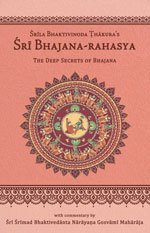Bhajana-Rahasya
by Srila Bhaktivinoda Thakura Mahasaya | 2010 | 123,965 words
The Bhajana-rahasya Text 7, English translation, including commentary (vritti). The Bhajana-rahasya is a compilation of verses describing the mercy of the eight pairs of names (Yugala-nama) of the Maha-mantra. This is text 7 belonging to the chapter “Ashtama-yama-sadhana (Ratri-lila–prema-bhajana sambhoga)” representing from midnight to three-and-a-half praharas of the night: approximately 00.00 a.m.–3.30 a.m.
Text 7
The rāgānuga-bhakta’s method of bhajana is to perform his desired eternal service (siddha-sevā ) under the constant guidance of the guru. Bhakti-rasāmṛta-sindhu (1.2.294) states:
कृष्णं स्मरन् जनं चास्य प्रेष्ठं निज-समीहितम्
तत्-तत्-कथा-रतश् चासौ कुर्याद् वासं व्रजे सदाkṛṣṇaṃ smaran janaṃ cāsya preṣṭhaṃ nija-samīhitam
tat-tat-kathā-rataś cāsau kuryād vāsaṃ vraje sadāThe devotee who desires rāgānuga-bhakti should constantly remember Vṛndāvana-Kṛṣṇa, along with Kṛṣna’s beloved assoc iates who have the same mood as him. He should remain engrossed in hearing and speaking narrations of their pastimes and always reside in Vraja.
स्मरि’ कृष्ण, निज-कृष्ण-प्रेष्ठ-व्रज-जन
कृष्ण-कथा-रत, व्रज-वास अनुक्षणsmari’ kṛṣṇa, nija-kṛṣṇa-preṣṭha-vraja-jana
kṛṣṇa-kathā-rata, vraja-vāsa anukṣaṇa
Commentary: Bhajana-rahasya-vṛtti:
The process of rāgānuga-bhakti is that the sādhaka should remember his beloved and worshipable, ever-youthful Nanda-nandana Śrī Kṛṣṇa, as well as the dear sakhīs, such as Śrī Rūpa Mañjarī, who possess the mood that he cherishes. He should hear narrations about them while remaining a resident of Śrī Nandarāja’s Vraja; that is, by physically residing in Vṛndāvana, Govardhana, Rādhā-kuṇḍa and other such places if he is able to do so. Or, if not, he should reside there mentally. These places are saturated with śṛṅgāra-rasa, and in bhajana, they are stimuli (uddīpaka) for spiritual rapture (rasa) and [remembrance of ] pastimes (līlā). Therefore, Śrīla Bhaktivinoda Ṭhākura prays: “rādhā-kuṇḍa-taṭakuñja-kuṭīra, govardhana-parvata, yāmuna-tīra–a vine-covered bower on the banks of Rādhā-kuṇḍa; Govardhana Hill; the banks of the Yamunā....”
Such sādhakas should remember the narrations of Kṛṣṇa’s dear associates, the rasika devotees of Vraja who are favourable for his bhāva, such as Śrī Rūpa Mañjarī and other sakhīs, and he should serve them. In this way, their moods will be transmitted into his heart. An example of this is Śrīla Raghunātha dāsa Gosvāmī who, under the guidance of Śrī Svarūpa Dāmodara and Śrīla Rūpa Gosvāmī, attained the summit of the rasamayī-upāsanā (devotional service in amorous love) of Vraja.
